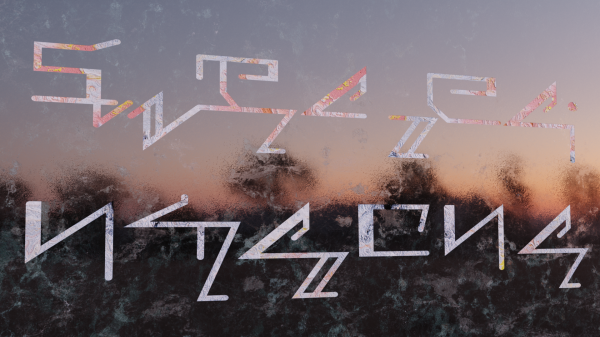BY LETTER
Heaven and I Wept Together
4th-millennium virchtext commemorating the Excelsior Incident | |
 Image from Tasp | |
| Rueetsam Aasmi, kha Yamaan kha Ma | |
Heaven and I Wept Together ("Rueetsam Aasmi, kha Yamaan kha Ma") is a virch narrative first published in ten installments to the Known Net (Corona Local Graph) in 3572 AT by Excelsian author Syrgaih Praamsha, with some consultation from the Coronan superturing artist StKw74. The work deals with the tragic Excelsior Incident, and is presented in a post-shekhinatic style, drawing from Centaurian Irrealist and Post-Psychallegoric influences. It is regarded by many critics as the most important artistic work to emerge from the Excelsior system [1], and is one of the best-known pieces of modosophont literature from the 4th millennium [2].
Syrgaih Praamsha is one of several trillion sohphonts created by the transcendent perversity Arise Eternal during the Excelsior Incident, at some point between 3476 and 3482 AT. Like all such victims of the Incident, Praamsha was once a different person, but had his personality, memory and body overwritten by Arise Eternal as part of the latter's effort to create a system-spanning tribemind housing eir own mindstate. The trauma of this revelation, the fragility of identity, and the tension between community and individuality are all major themes within Praamsha's work.
The main viewpoint of the virchtext is that of Rafatzi Een Kolabodmri, a modosophont denizen of Saraama, a magically-solid Dyson sphere with radius equal to the mean orbital radius of the Excelsian capital planet of Maakra. The main narrative follows Rafatzi's journey through a sprawling, surreal worldscape in which almost everyone they meet is a distorted reflection of their own personality. Sub-narratives, sprinkled (often very suddenly) throughout the main story, outline the lives of the fictional Viitrshk, presented as ten exalted Centauri Vehicle sages, each corresponding to a planet of the Excelsior system [3]. Each of these eventually meets a brutal death at the hands of the dhuurta, angelic emissaries of the unnamed and eternally-unknown creator deity at the heart of Saraama. The narrative begins in medias res and ends abruptly, before Rafatzi has achieved their ultimate goal. Careful attention during the virch experience also reveals a series of hidden text-only poems written by Praamsha, most of which are letters to his forgotten previous self, during various imagined stages of their personality rewrite.
 Image from Tasp | |
| One of the virch's surreal environments. | |
After publishing Heaven, Praamsha became a local celebrity in the Excelsior system. Many of the 500th-anniversary Excelsior Incident monuments make at least passing reference to him or one of his fictional characters. After several hundred years of lionization in his home system, he greatly relaxed his exoself constraints and allowed his personality to vary wildly over the course of the next two millennia, eventually legally reclassifying himself as another person entirely [4].
Heaven and I Wept Together is regarded by many scholars of Terragen literature as a direct, if obscure, precursor to What the Thunder Said, Menno Singh's acclaimed compilation of transapient responses to modosophont questions. While Singh has never publicly addressed such influence, he is known to have experienced Heaven and expressed approval of the work prior to his transcension, although some statements made by his transapient descendant may be construed to constitute harsh criticisms. While the overt tenor of the statements is unambiguously disapproving, the arguments themselves rely on post-singularity text-critical concepts that evade representation in modosophont-understandable terms—ultimately, interpretation may be impossible.
Footnotes
[1] ↩ Superbright scholar of Excelsian history Rivers in the Sun, whose academic study of the Excelsior Incident spans almost a full millennium, argues convincingly throughout their body of work that Heaven represents a single axial point for all major Excelsian art, and classifies all such works as either pre-Heaven or post-Heaven.[2] ↩ For S:<2 citizens of most Sephirotic Empires, the work consistently scores at or above the 73rd percentile on the Ken Ferjik Index of Primed Declarative Recognition, v. 31.1.0 and later.
[3] ↩ Presumably based on the prevailing theory of the origin of the names of the Excelsian planets: many modern scholars contend that they are named after an obscure Interplanetary-Era decad of Buddhist figures called "The Ten Royal Sages", about whom little reliable information survives. They are speculated to have been, or been associated with, bodhisattvas or buddhas; garbled references to similar figures are dated to the Federation Age or before.
[4] ↩ The Encyclopaedia Galactica Institute respects the privacy of the new personality, and declines to identify them further.
Related Articles
Appears in Topics
Development Notes
Text by Tasp
Initially published on 02 October 2024.
Initially published on 02 October 2024.






